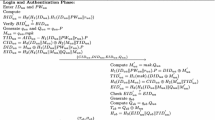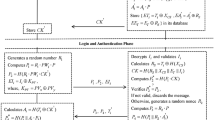Abstract
Internet of things (IoT) has become a new era of communication technology for performing information exchange. With the immense increment of usage of smart devices, IoT services become more accessible. To perform secure transmission of data between IoT network and remote user, mutual authentication, and session key negotiation play a key role. In this research, we have proposed an ECC-based three-factor remote user authentication scheme that runs in the smart device and preserves privacy, and data confidentiality of the communicating user. To support our claim, multiple cryptographic attacks are analyzed and found that the proposed scheme is not vulnerable to those attacks. Finally, the computation and communication overheads of the proposed scheme are compared with other existing protocols to confirm that the proposed scheme is lightweight. A formal security analysis using AVISPA simulation tool has been done that confirms the proposed scheme is robust against relevant security threats.














Similar content being viewed by others
References
Ahmed MR, Huang X, Sharma D, Cui H (2012) Wireless sensor network: characteristics and architectures. Int J Electr Comput Energ Electron Commun Eng 6(12):1398–1401
Henze M, Hermerschmidt L, Kerpen D, Häußling R, Rumpe B, Wehrle K (2016) A comprehensive approach to privacy in the cloud-based Internet of Things. Future Gener Comput Syst 56:701–718
Jing Q, Vasilakos VA, Wan J, Lu J, Qiu D (2014) Security of the Internet of Things: perspectives and challenges. Wirel Netw 20(8):2481–2501
Li L (2012) Study on security architecture in the Internet of Things. In: 2012 International Conference on Measurement, Information and Control (MIC), vol 1. IEEE, pp 374–377
Wu F, Xu L, Kumari S, Li X, Shen J, Choo KKR, Das AK (2017) An efficient authentication and key agreement scheme for multi-gateway wireless sensor networks in IoT deployment. J Netw Comput Appl 89:72–85
Amin R, Kumar N, Biswas GP, Iqbal R, Chang RV (2018) A light weight authentication protocol for IoT-enabled devices in distributed Cloud Computing environment. Future Gener Comput Syst 78:1005–1019
Atzori L, Iera A, Morabito G (2010) The internet of things: a survey. Comput Netw 54(15):2787–2805
Jiang Q, Wei F, Fu S, Ma J, Li G, Alelaiwi A (2016) Robust extended chaotic maps-based three-factor authentication scheme preserving biometric template privacy. Nonlinear Dyn 83(4):2085–2101
Wazid M, Das AK, Odelu V, Kumar N, Conti M, Jo M (2018) Design of secure user authenticated key management protocol for generic iot networks. IEEE Internet of Things J 5(1):269–282
Das AK, Goswami A (2015) A robust anonymous biometric-based remote user authentication scheme using smart cards. J King Saud Univ Comput Inf Sci 27(2):193–210
Kumari S, Li X, Wu F, Das AK, Arshad H, Khan MK (2016) A user friendly mutual authentication and key agreement scheme for wireless sensor networks using chaotic maps. Future Gener Comput Syst 63:56–75
Souissi I, Azzouna NB, Said LB (2019) A multi-level study of information trust models in WSN-assisted IoT. Comput Netw 151:12–30
Weber RH (2010) Internet of Things-New security and privacy challenges. Comput Law Secur Rev 26(1):23–30
Gubbi J, Buyya R, Marusic S, Palaniswami M (2013) Internet of Things (IoT): a vision, architectural elements, and future directions. Future Gener Comput Syst 29(7):1645–1660
Chang E, Thomson P, Dillon T, Hussain F (2005) The fuzzy and dynamic nature of trust. In: International Conference on Trust, Privacy and Security in Digital Business. Springer, Berlin, pp 161–174
Yan Z, Zhang P, Vasilakos AV (2014) A survey on trust management for Internet of Things. J Netw Comput Appl 42:120–134
Xue K, Ma C, Hong P, Ding R (2013) A temporal-credential-based mutual authentication and key agreement scheme for wireless sensor networks. J Netw Comput Appl 36(1):316–323
Wang D, Zhang X, Zhang Z, Wang P (2020) Understanding security failures of multi-factor authentication schemes for multi-server environments. Comput Secur 88:101619
Sood SK, Sarje AK, Singh K (2010) An improvement of Wang et al.’s authentication scheme using smart cards. In: 2010 National Conference on Communications (NCC). IEEE, pp 1–5
Song R (2010) Advanced smart card based password authentication protocol. Comput Standards Interfaces 32(5–6):321–325
Chen TH, Hsiang HC, Shih WK (2011) Security enhancement on an improvement on two remote user authentication schemes using smart cards. Future Gener Comput Syst 27(4):377–380
Kumari S, Khan MK (2014) Cryptanalysis and improvement of ‘a robust smart-card-based remote user password authentication scheme’. Int J Commun Syst 27(12):3939–3955
Mishra D, Das AK, Chaturvedi A, Mukhopadhyay S (2015) A secure password-based authentication and key agreement scheme using smart cards. J Inf Secur Appl 23:28–43
Sharma G, Kalra S (2018) A lightweight multi-factor secure smart card based remote user authentication scheme for cloud-IoT applications. J Inf Secur Appl 42:95–106
Porambage QP, Schmitt C, Kumar P, Gurtov A, Ylianttila M (2014) Two-phase authentication protocol for wireless sensor networks in distributed IoT applications. In: Proceedings of IEEE Wireless Communications and Networking Conference (WCNC), Istanbul, Turkey, pp 2728–2733
Turkanović M, Brumen B, Hölbl M (2014) A novel user authentication and key agreement scheme for heterogeneous ad hoc wireless sensor networks, based on the Internet of Things notion. Ad Hoc Netw 20:96–112
Amin R, Biswas GP (2016) A secure light weight scheme for user authentication and key agreement in multi-gateway based wireless sensor networks. Ad Hoc Netw 36:58–80
Kalra S, Sood SK (2015) Secure authentication scheme for IoT and cloud servers. Pervasive Mob Comput 24:210–223
Kumari S, Karuppiah M, Das AK, Li X, Wu F, Kumar N (2018) A secure authentication scheme based on elliptic curve cryptography for IoT and cloud servers. J Supercomput 74(12):6428–6453
Chang C-C, Le H-D (2016) A provably secure, efficient, and flexible authentication scheme for ad hoc wireless sensor networks. IEEE Trans Wirel Commun 15(1):357–366
Dhillon PK, Kalra S (2017) A lightweight biometrics based remote user authentication scheme for IoT services. J Inf Secur Appl 34:255–270
Souri A, Norouzi M (2019) A state-of-the-art survey on formal verification of the internet of things applications. J Serv Sci Res 11(1):47–67
Challa S, Wazid M, Das AK, Kumar N, Reddy AG, Yoon EJ, Yoo KY (2017) Secure signature-based authenticated key establishment scheme for future IoT applications. IEEE Access 5:3028–3043
Fakroon M, Alshahrani M, Gebali F, Traore I (2020) Secure remote anonymous user authentication scheme for smart home environment. Internet of Things, p 100158
Hussain K, Jhanjhi NZ, Mati-ur-Rahman H, Hussain J, Islam MH (2019) Using a systematic framework to critically analyze proposed smart card based two factor authentication schemes. J King Saud Univ Comput Inf Sci 2019
Shuai M, Yu N, Wang H, Xiong L (2019) Anonymous authentication scheme for smart home environment with provable security. Comput Secur 86:132–146
Hankerson D, Menezes AJ, Vanstone S (2006) Guide to elliptic curve cryptography. Springer, Berlin
Kapoor V, Abraham VS, Singh R (2008) Elliptic curve cryptography. Ubiquity 20:7
Koblitz N (2000) Towards a quarter-century of public key cryptography. Kluwer Academic, Dordrecht
Miller VS (1985) Use of elliptic curves in cryptography. In: Conference on the Theory and Application of Cryptographic Techniques. Springer, Berlin, pp 417–426
Stallings W (2006) Cryptography and network security: principles and practices. Pearson Education India
Ray S, Biswas GP (2012) Establishment of ECC-based initial secrecy usable for IKE implementation. In: Proceedings of World Congress on Expert Systems (WCE)
Ray S, Biswas GP (2011) Design of mobile-PKI for using mobile phones in various applications. In: 2011 International Conference on Recent Trends in Information Systems (ReTIS). IEEE, pp 297–302
Ray S, Biswas GP (2012) An ECC based public key infrastructure usable for mobile applications. In: Proceedings of the Second International Conference on Computational Science, Engineering and Information Technology. ACM, pp 562–568
Ray S, Biswas GP, Dasgupta M (2016) Secure multi-purpose mobile-banking using elliptic curve cryptography. Wirel Pers Commun 90(3):1331–1354
Paar C, Pelzl J (2009) Understanding cryptography: a textbook for students and practitioners. Springer, Berlin
Guajardo J, Paar C (1997) Efficient algorithms for elliptic curve cryptosystems. In: Annual International Cryptology Conference. Springer, Berlin, pp 342–356
Moon AH, Iqbal U, Bhat GM (2016) Mutual entity authentication protocol based on ECDSA for WSN. Proc Comput Sci 89:187–192
Lynn B (2007) On the implementation of pairing-based cryptosystems (Doctoral dissertation, Stanford University)
Kilinc HH, Yanik T (2014) A survey of SIP authentication and key agreement schemes. IEEE Commun Surv Tutor 16(2):1005–1023
He D, Gao Y, Chan S, Chen C, Bu J (2010) An enhanced two-factor user authentication scheme in wireless sensor networks. Ad hoc Sens Wirel Netw. 10(4):361–371
Hernández-Ramos JL, Moreno MV, Bernabé JB, Carrillo DG, Skarmeta AF (2015) SAFIR: secure access framework for IoT-enabled services on smart buildings. J Comput Syst Sci 81(8):1452–1463
Viganò L (2006) Automated security protocol analysis with the AVISPA tool. Electron Notes Theor Comput Sci 155:61–86
Reddy G, Das AK, Yoon E, Yoo K (2016) A secure anonymous authentication protocol for mobile services on elliptic curve cryptography. IEEE Access 4:4394–4407
Islam SKH, Amin R, Biswas GP, Farash MS, Li X, Kumari S (2017) An improved three party authenticated key exchange protocol using hash function and elliptic curve cryptography for mobile-commerce environments. J King Saud Univ Comput Inf Sci 29(3):311–324
Author information
Authors and Affiliations
Corresponding author
Additional information
Publisher's Note
Springer Nature remains neutral with regard to jurisdictional claims in published maps and institutional affiliations.
Rights and permissions
About this article
Cite this article
Sadhukhan, D., Ray, S., Biswas, G.P. et al. A lightweight remote user authentication scheme for IoT communication using elliptic curve cryptography. J Supercomput 77, 1114–1151 (2021). https://doi.org/10.1007/s11227-020-03318-7
Published:
Issue Date:
DOI: https://doi.org/10.1007/s11227-020-03318-7




